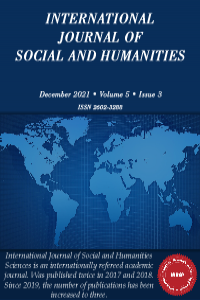THE ‘COLOUR’ OF IMMIGRANT LITERATURE IN THE SELECTED FICTION OF AFRICAN AMERICAN AND WHITE AMERICAN WRITERS
Öz
Paris is a metropolitan city with its urban characteristics that have been shaped by its artistic monuments and history. There was a wave of immigration by white Americans to Paris at the beginning of the twentieth century. This wave of immi-grants included several artists, journalists, and writers, who were disillusioned by the promises of the New World, America. These were as Gertrude Stein’s described created a ‘lost generation’ in Europe. At the second half of the twentieth century, there appeared another wave of immigration to Europe, this time mainly by Afri-can-Americans. Their experiences and conditions differed from that of white pio-neers. They were more liberal and stood for freedom rather than getting lost in Par-is. Their previous situation in America was one of restlessness; they had to run away from hatred levelled against their skin colour or sexuality. They pointed to social problems back in America and pronounced the freedom of speech they earned Paris. This article aims to explore the extent to which the African-American literary experience of Paris after World War II differed from that of white American writers earlier in the century. The paper critically compares the selected fiction by accomplished authors such as Ernest Hemingway’s The Sun Also Rises (1926), F. Scott Fitzgerald’s ‘Babylon Revisited’ (1931), Richard Wright’s The Outsider (1953) and James Baldwin’s Giovanni’s Room (1956). This article concludes that the two literary experience that were shaped in Paris vigorously differed in their motives and motivations in reflecting the expectations of exile, the experience of sexuality and the treatment of women.
Anahtar Kelimeler
Kaynakça
- Abdur-Rahman, A. I. (2007). “Simply a Menaced Boy”: Analogizing Color, Undoing Dominance in James Baldwin's Giovanni's Room. African American Re-view 41(3): 477-86.
- Baldwin, J. (2007). Giovanni’s Room. London: Penguin.
- Beemyn, B. (2001). To Say Yes to Life. Journal of Bisexuality 2(1): 55-72.
- Blower, B. L. (2010) Becoming Americans in Paris: Transatlantic Politics and Culture Between the Wars. Oxford: Oxford University Press.
- Del Gizzo, S. (2007). Fitzgerald and Hemingway. American Literary Schol-arship: 211-32.
- Field, A. N. (2006). Expatriate Lifestyle as Tourist Destination: The Sun Also Rises and Experiential Travelogues of the Twenties. The Hemingway Review 25(2): 29-43.
- Fitzgerald, F. S. (1986). Babylon Revisited. In The Collected Short Stories. London: Penguin.
- Gopnik, A. (2004). Americans in Paris. The American Scholar 73(2): 13-30.
- Hemingway, E. (2011). The Sun Also Rises. London: Thinking Ink.
- Henderson, M. G. (2000). James Baldwin: Expatriation, Homosexual Panic, and Man’s Estate. Callaloo 23(1): 313-27.
- Kramer, L. (2001). James Baldwin in Paris: Exile, Multiculturalism and the Public Intellectual. Historical Reflections 27(1): 27-47.
- Relyea, S. (2006). The Vanguard of Modernity: Richard Wright’s The Out-sider. Texas Studies in Literature and Language 48(3): 187-219.
- Soto, M. (2001). Hemingway Among the Bohemians: A Generational Read-ing of The Sun Also Rises. The Hemingway Review 21(1): 5-21.
- Tebbetts, T. L. (2005). “Commodifying Character: Why the Past Entraps in ‘Babylon Revisited’”. The F. Scott Fitzgerald Review 4 (2005) 147-61.
- Tomkins, D. (2008). The “Lost Generation” and the Generation of Loss: Ernest Hemingway’s Materiality of Absence and The Sun Also Rises. Modern Fic-tion Studies 54(4): 744-65.
- Wagner, L. W. (1980). “Proud and Friendly and Gently”: Women in Hem-ingway’s Early Fiction. College Literature 7(3): 239-47.
- Wright, R. (1993). The Outsider. New York: Harper Collins.
Öz
Kaynakça
- Abdur-Rahman, A. I. (2007). “Simply a Menaced Boy”: Analogizing Color, Undoing Dominance in James Baldwin's Giovanni's Room. African American Re-view 41(3): 477-86.
- Baldwin, J. (2007). Giovanni’s Room. London: Penguin.
- Beemyn, B. (2001). To Say Yes to Life. Journal of Bisexuality 2(1): 55-72.
- Blower, B. L. (2010) Becoming Americans in Paris: Transatlantic Politics and Culture Between the Wars. Oxford: Oxford University Press.
- Del Gizzo, S. (2007). Fitzgerald and Hemingway. American Literary Schol-arship: 211-32.
- Field, A. N. (2006). Expatriate Lifestyle as Tourist Destination: The Sun Also Rises and Experiential Travelogues of the Twenties. The Hemingway Review 25(2): 29-43.
- Fitzgerald, F. S. (1986). Babylon Revisited. In The Collected Short Stories. London: Penguin.
- Gopnik, A. (2004). Americans in Paris. The American Scholar 73(2): 13-30.
- Hemingway, E. (2011). The Sun Also Rises. London: Thinking Ink.
- Henderson, M. G. (2000). James Baldwin: Expatriation, Homosexual Panic, and Man’s Estate. Callaloo 23(1): 313-27.
- Kramer, L. (2001). James Baldwin in Paris: Exile, Multiculturalism and the Public Intellectual. Historical Reflections 27(1): 27-47.
- Relyea, S. (2006). The Vanguard of Modernity: Richard Wright’s The Out-sider. Texas Studies in Literature and Language 48(3): 187-219.
- Soto, M. (2001). Hemingway Among the Bohemians: A Generational Read-ing of The Sun Also Rises. The Hemingway Review 21(1): 5-21.
- Tebbetts, T. L. (2005). “Commodifying Character: Why the Past Entraps in ‘Babylon Revisited’”. The F. Scott Fitzgerald Review 4 (2005) 147-61.
- Tomkins, D. (2008). The “Lost Generation” and the Generation of Loss: Ernest Hemingway’s Materiality of Absence and The Sun Also Rises. Modern Fic-tion Studies 54(4): 744-65.
- Wagner, L. W. (1980). “Proud and Friendly and Gently”: Women in Hem-ingway’s Early Fiction. College Literature 7(3): 239-47.
- Wright, R. (1993). The Outsider. New York: Harper Collins.
Ayrıntılar
| Birincil Dil | İngilizce |
|---|---|
| Bölüm | Araştırma Makalesi |
| Yazarlar | |
| Yayımlanma Tarihi | 31 Aralık 2021 |
| Yayımlandığı Sayı | Yıl 2021 Cilt: 5 Sayı: 3 |


